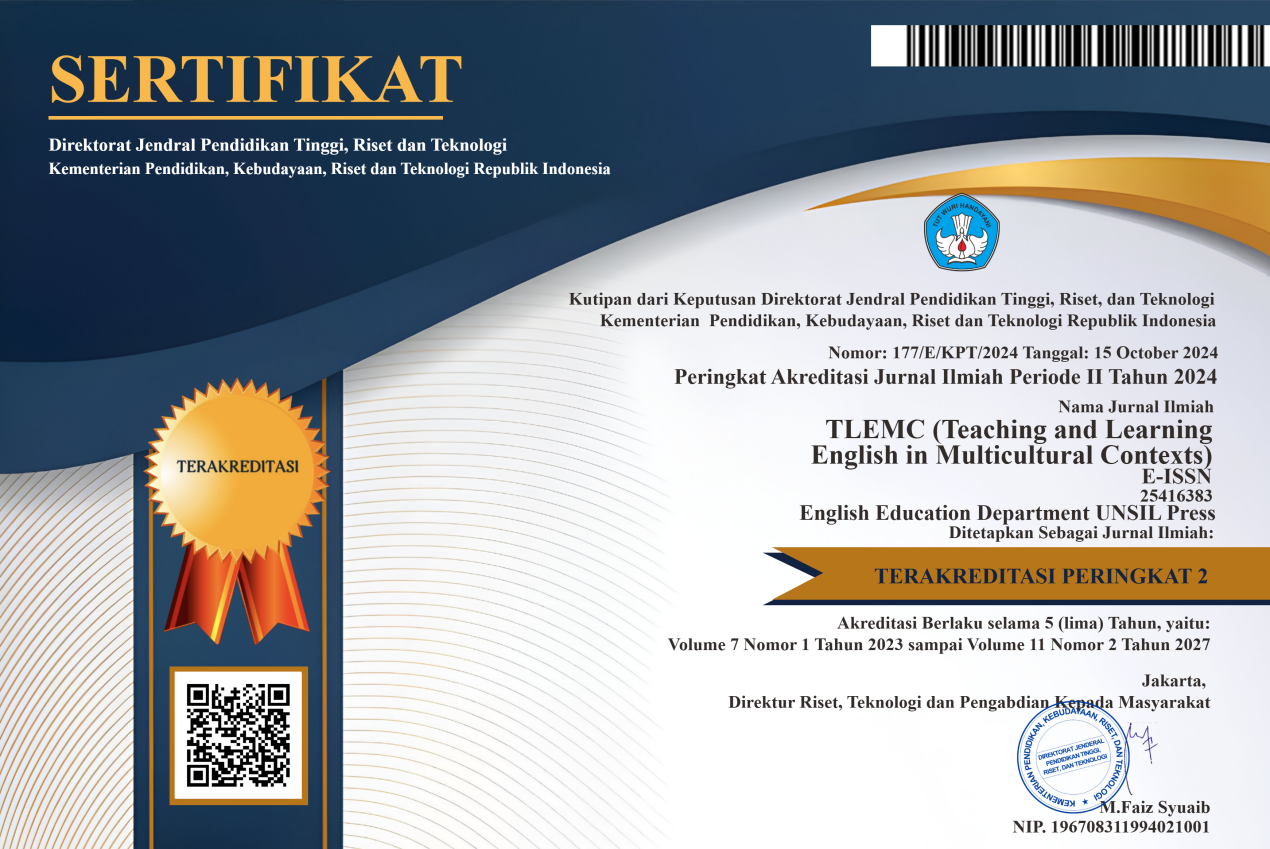GENDER REPRESENTATION IN INDONESIAN EFL HIGH SCHOOL TEXTBOOK THROUGH CONVERSATION TEXTS
Abstract
Full Text:
PDFReferences
Amare, N. (2007). “Where is She? Gender Occurrences in Online Grammar Guides.†Research in the Teaching of English 42 (2): 163–187.
Bandura, A. (1997). Self-Efficacy: The Exercise of Control. New York: W. H. Freeman.
Barakat, B., & Bengtsson, S. (2018). What do we mean by school entry age? Conceptual ambiguity and its implications: the example of Indonesia. Comparative Education, 54(2), 203–224. https://doi.org/10.1080/03050068.2017.1360564
Bryman, Allan. (2012). Social Research Method fourth edition. New York: Oxford University Press, Inc.
Chan, Jim Yee H. (2018). Gender and attitudes towards English varieties: Implications for teaching English as a global language. System. DOI: https://doi.org/10.1016/j.system.2018.04.010.
Emilia, E., Moecharam, N. Y., & Syifa, I. L. (2017). Gender in Efl Classroom: Transitivity Analysis in English Textbook for Indonesian Students. Indonesian Journal of Applied Linguistics, 7(1), 206. https://doi.org/10.17509/ijal.v7i1.6877
Frasher, R., & Walker, A. (1972). Sex roles in early reading textbooks. Reading Teacher, 25(8), 741–749. Retrieved from https://link.ezproxy.neu.edu/login?url=http://search.ebscohost.com/login.aspx?direct=true&db=psyh&AN=1973-31984-001&site=ehost-live&scope=site
Hamdan, S. (2011). Identifying the Linguistic Genderlects of the Style of Writing of Arab Male and Female Novelists. Journal of Education Culture and Society No.2_2011, pp. 55 – 62. Doi: 10.15503/jecs20112-55-63.
Holmes, J., and Meyerhoff, M., (2003). The Handbook of Language and Gender. UK: Blackwell Publishing Ltd.
Jannati, S. (2015) ‘Gender Representation in EFL Textbooks : A Case of ILI Pre-intermediate Series,' Journal of Applied Linguistics and Language Research, 2(3), pp. 211–222.
Koenig, A. M. (2018). Comparing prescriptive and descriptive gender stereotypes about children, adults, and the elderly. Frontiers in Psychology, 9(JUN). https://doi.org/10.3389/fpsyg.2018.01086
Law, K. W. K., & Chan, A. H. N. (2016). Gender Role Stereotyping in Hong Kong’s Primary School Chinese Language Subject Textbooks. 9276(March). https://doi.org/10.1080/12259276.2004.11665965
Leavitt, R. 1971. Women in other cultures. In V. Gornick & B. Moran (Eds.), Women in sexist society (pp. 276–301). New York: Basic Books.
Lee, J. F. K. (2016). Gender representation in Japanese EFL textbooks – a corpus study Gender representation in Japanese EFL textbooks – a corpus study. 0253(August). https://doi.org/10.1080/09540253.2016.1214690
Litosseliti, L. (2006). Gender and Language: Theory and Practice. London: Hodder Arnold.
Lowe, R. (2013). Wolves in sheep’s clothing: Problematic representations of gender in authentic EFL vocabulary texts. The Journal and Proceeding of the Gender Awareness in Language Education (GALE) Special Interest Group of the Japan Association for Language Teaching, 6.
Macleod, M., & Norrby, C. (2016). SEXUAL STEREOTYPING IN SWEDISH LANGUAGE TEXTBOOKS. 2793(April). https://doi.org/10.1179/aulla.2002.97.1.005
Miles, Matthew B. and Huberman, A. Michael. (1994). An Expanded Sourcebook Qualitative Data Analysis. USA: SAGE Publication Inc.
Mujiyanto, Yan. (2016). The Dependence of Verbal Passages on Visual Representation in Meaning-Making. A paper presented on International Seminar PRASASTI III: Current Research in Linguistics. Solo: Universitas Sebelas Maret
Pascarella, E. and Patrick T. Terenzini. (2005). How College Affects Students: A Third Decade of Research (Vol. 2). Jossey-Bass: San Francisco.
Pauwels, A., and J. Winter. (2006). “Gender Inclusivity or ‘Grammar Rules OK’? Linguistic Prescriptivism vs Linguistic Discrimination in the Classroom.†Language and Education 20 (2): 128–140.
Perry, William G. (1970). Forms of Intellectual and Ethical Development in the College Years: A Scheme. New York: Holt, Rinehart and Winston, Inc.
Poulou, S. (2007). Sexism in the discourse roles of textbook dialogues Sexism in the discourse roles of textbook dialogues. (October 2014), 37–41. https://doi.org/10.1080/09571739785200141
Reidy, Charlene G. (2013). Students’ Awareness of Gender Dynamics in the College Classroom Theses and Dissertations. Paper 1602.
Schmitz, B. (1975). Sexism in French language textbooks. In R. C. Lafayette (Ed.), The cultural revolution in foreign language teaching (119-130). Skokie, Illinois: National Textbook Company.
Setyono, B. (2018). The Portrayal of Women in Nationally-Endorsed English as a Foreign Language (EFL) Textbooks for Senior High School Students in Indonesia. Sexuality and Culture, 22(4), 1077–1093. https://doi.org/10.1007/s12119-018-9526-2
Sirén, T. (2018). Representations of men and women in English language textbooks. A critical discourse analysis of Open Road 1-7. Retrieved from http://jultika.oulu.fi/files/nbnfioulu-201805312348.pdf
Sunderland, J. (2000). New understandings of gender and language classroom research: Texts, teacher talk and student talk. Language Teaching Research, 4(2), 149–173. https://doi.org/10.1177/136216880000400204
Sunderland, J., & Shattuck, J. (2001). From Bias “In the Text†to “Teacher Talk Around the Text†An Exploration of Teacher Discourse and Gendered Foreign Language Textbook Texts. 11(3), 251–286.
Sunderland, J. (2014). Teaching : Issues of language and gender in second and foreign language education Review article. (June 2009), 203–223. https://doi.org/10.1017/S0261444800015688
Thomas, David R. (2016). Feedback from research participants: are member checks useful in qualitative research?. Qualitative Resesarch in Psychology. DOI: 10.1080/14780887.2016.1219435.
Tomlison, B. (1998). Materials Development in Language Teaching. Cambridge: Cambridge University press.
Vandello, J. A., and Bosson, J. K. (2013). Hard won and easily lost: a review of synthesis of theory and research on precarious manhood. Psychol. Men. Mascul. 14, 101-113. DOI: 10.1037/a0029826.
Virga, Diane G. (1983). A survey of student awareness of gender equity at the community college level. These Digitization Project. 178.
Woolever, R. (1982). Affirmative action in the classroom: What would it mean? Social Education, 46(1), 45-48.
Yang, C. C. R. (2016). Are males and females still portrayed stereotypically? Visual analyses of gender in two Hong Kong primary English Language textbook series. Gender and Education, 28, 674–692. https://doi.org/10.1080/09540 253.2015.11038 39.
Yonata, F. and Mujiyanto, Y. (2017). The Representation of Gender in English Textbooks in Indonesia. Language Circle - Journal of Language and Literature, 12(1), 91–102. https://doi.org/10.15294/lc.v12i1.11473.
DOI: https://doi.org/10.37058/tlemc.v3i2.1273
Refbacks
- There are currently no refbacks.
INDEXED BY:
This work is licensed under a Creative Commons Attribution-NonCommercial-ShareAlike 4.0 International License.
![]()
TLEMC (Teaching and Learning English in Multicultural Contexts)
Program Studi Pendidikan Bahasa Inggris
Fakultas Keguruan dan Ilmu Pendidikan
Universitas Siliwangi
Jl. Siliwangi No. 24 Kota Tasikmalaya - 46115
email: tlemc@unsil.ac.id





